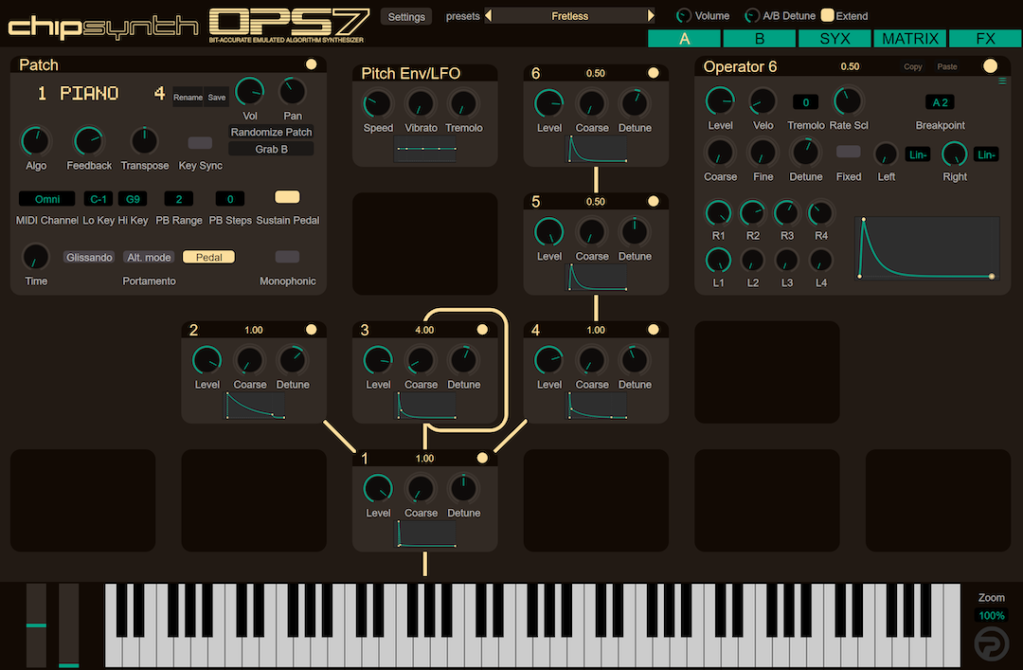Transport yourself to 1983. Sure, analog emulation is all the rage. But leave it to Plogue to do bit-for-bit digital recreation – with a precise reproduction of the Yamaha 6-operator FM synth range, including the legendary FM7.
Meet the Chipsynth OPS7.
This may sound bonkers. Okay, it is realistically bonkers. But it’s also worth saying, the DX7 and its ilk from Yamaha have taken on a different meaning to our 2021 selves than the machines’ 1980s users. To many synthesists of the mid-80s, the Yamaha keyboards were perfect preset machines, clean and digital and predictable, and the analog devices that came before them were relabeled junk.
Since then, though, we’ve all become more cyborg-like in our music machine tastes. We’ve gone back to the hands-on editing of the analog instruments of the age. And sounds that were unacceptable in the 80s sound deliciously edgy to our more adventurous modern ears. So the OPS7 mimics every detail. We’re no longer afraid of the algorithms inside, and we have computer screens to use as editors, so in place of Yamaha’s horrible diagrams and black-box “we don’t need knobs” design, you get a new dynamic patch editing system that lets you dig into every detail.
But maybe in the 2020s, musicians are also growing more interested in the eccentricities of the originals – call it digital antique. So the Chipsynth OPS7 has stuff that other FM plug-ins largely ignored:

- Note-to-note variations in envelope stepping patterns
- Weird pitch calculation
- “Identical operator math for each algorithm down to the bit”
- Unique compander (dynamic processing)
- Full analog filtering emulation (since this portion of the Yamaha FM line’s output stage was in fact analog – from the manual “Filtering: Selects the output filter being emulated. The original synth has a filter at 16khz but different modeled keyboards have slight variations.”)
- The crunch original DAC (the ‘A’ in DAC of course being analog, too…)
- Multi-layer system as seen in the ultra-luxury DX1 and DX5
And there are absolutely no samples.
Plus since it is bit-for-bit accurate, you can play the 6-op patch banks from the original Yamaha DX line and their SysEx bank file support and even full hardware SysEx interfacing.
Listen to the wonderful music coming out of this thing:
To be perfectly frank, I hadn’t really taken into account how much unlike the DX7 and siblings the plug-ins sound until I heard Plogue’s offering. Suddenly, you realize how much of the Yamaha sound is here. No one has done this – not Yamaha themselves, even. (KORG’s volca fm actually came closest, if in its own idiosyncratic volca-ish way.)
There’s also NKS support for Native Instruments’ stuff. Frankly, it’s a better FM synth than NI’s own FM8; I wish it ran on Maschine+, too. (Collab, perhaps?)
Runs on all 64-bit versions and standalone. Hey, David, please support Linux! Would be great to see this on a dedicated box.
Feature overview:
It’s not just your imagination that this sounds like the original. You know, I always thought this was some kind of psychological impact of seeing that dusty-brown original keyboard that made an DX7 sound the way it does. It’s not. Plogue really nailed the sound.
And this opens up other possibilities. I remember weird granular synthesis creations on the TX816 by Gary Lee Nelson. Now it’s possible to actually reproduce those with all the weird edges of the original Yamaha hardware.
How much work was this? So much work.
https://www.plogue.com/products/chipsynth-ops7.html
Roughly fifty bucks / fifty EUR with VAT. That’s better than you’ll do on the used market, for sure.
And yes, that means we got a new Yamaha and a new Ensoniq in the same week. More on Arturia’s entry shortly – and I have both to play with, so now as I recover from Superbooth, I better get busy in the studio. Good night; see you… later.